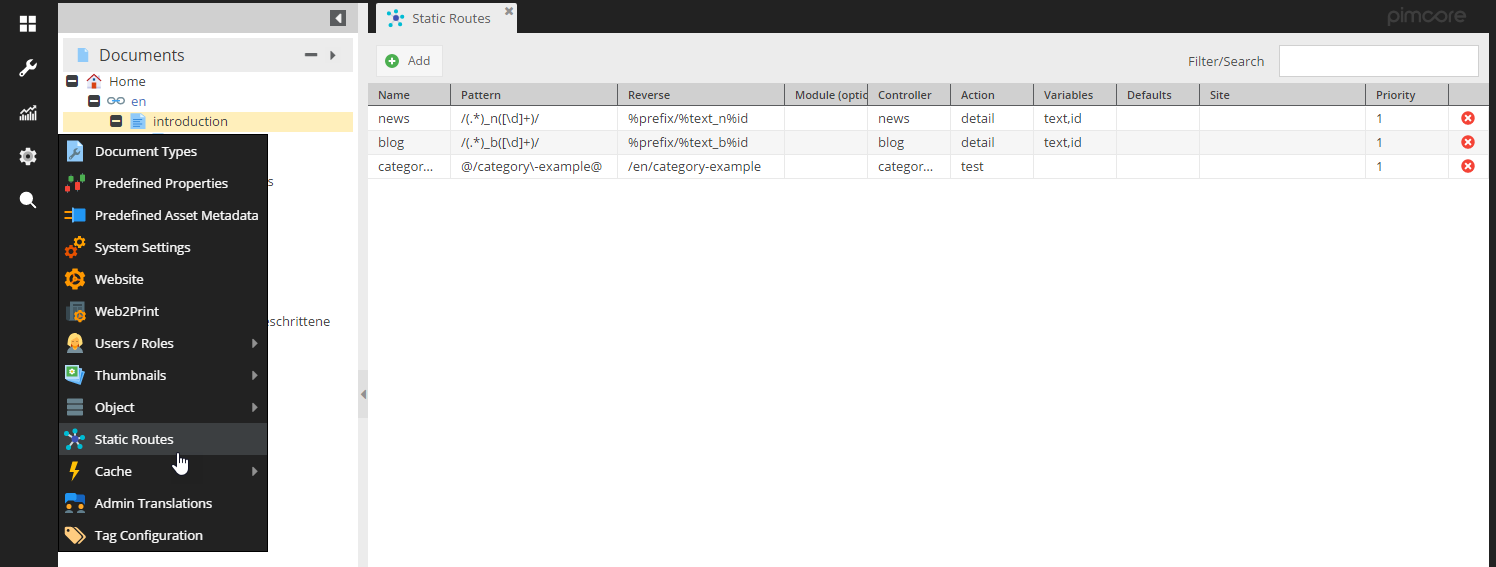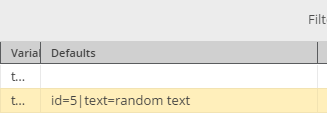URLs Based on Custom (Static) Routes
Introduction
Static routes are necessary for functionalities where you don't have an underlying document or where you have the need of dynamic URLs. For example you have a news list, which is generated out of a Pimcore object list and you want to give the news a detail page. Or you want create product lists with detail pages, or cart pages, a checkout process, ...
All things where Documents are not practical. Here Custom Routes come into action and allow the definition of URL patterns that are delegated to specific controllers with specific views.
Custom Routes come fourth in the route processing priority.
Custom routes are an alternative to Symfony's routing functionalities and give you a bit more flexibility, but you can
still use Symfony's routing capabilities (eg. @Route() annotation,
routing.yml, ...) in parallel to Pimcore Custom Routes.
Configuring Custom Routes
Custom Routes are configured in the Pimcore backend interface as follows.

Following options are relevant:
- Name - name of the Custom Route for identifying it
- Pattern - URL pattern configured with a regex
- Reverse - reverse pattern that is used to build URLs for this route, see also Building URLs.
- Bundle - When this column is filled, Pimcore routes the request to a different bundle than the standard bundle (AppBundle).
- Controller, Action - configuration for which controller/action the request is delegated to. You can use a Service as Controller Name as well. In this case, the Bundle Setting will be ignored
- Variables - comma-seperated list of names for the placeholders in the pattern regex. At least all variables used in the reverse pattern must be listed here.
- Defaults - defaults for variables separated by | - e.g. key=value|key2=value2
- Site - Site for which this route should be applied to.
- Priority - priority in resolving the URL pattern.
Routes are saved in PHP configuration files on the file system (var/config/staticroutes.php), so it's also possible to edit them directly in your
favorite IDE and keep track of the changes in your VCS (eg. Git).
Accessing Variables in Controller
This is how you can access (form a controller action) the values of the variables (placeholders) you specified in the custom route:

<?php
namespace AppBundle\Controller;
use Pimcore\Controller\FrontendController;
use Symfony\Component\HttpFoundation\Request;
class NewsController extends FrontendController
{
public function detailAction(Request $request)
{
$id = $request->get('id');
$text = $request->get('text');
// ...
}
}
The default variables can be accessed the same way.
Building URLs based on Custom Routes
URLs are generated using the default URL helper of Symfony $this->path() and $this->url(). Additionally to the
standard helpers for generating URLs, Pimcore offers a special templating helper ($this->pimcoreUrl()) to generate URLs like you did with Pimcore 4.
You can define a placeholder in the reverse pattern with %NAME and it is also possible to define an optional part,
to do so just embrace the part with curly brackets { } (see example below).
| Name | Pattern | Reverse | Module | Controller | Action | Variables | Defaults | Site | Priority |
|---|---|---|---|---|---|---|---|---|---|
| news category | /\/news-category\/([^]+)([0-9]+)(category)?([0-9]+)?/ | /news-category/%text_%id{category%category_id} | news | list | text,id,text2,categoryId | 1 |

Due to optional parameters, the above example matches for the following URL's:
- /news-category/testcategory_12_category_2
- /news-category/testcategory_12
Generating URL with Optional Parameters
Source url: /some-other-url
$this->path('news category', [
'text' => 'Test',
'id' => 67,
'categoryId' => 33,
'getExample' => 'some value'
]);
Since there is no default parameter available out of the route pattern, you have to set every not optional parameter. In addition there is one parameter which is not in the reverse route. That will be added as a normal GET parameter in the URL.
Output will be: /news-category/test_67_category_33?getExample=some+value
Adding Default Values to the Route
You can use the Defaults column to add default values which will be used if you don't specify parameters in the url helper.
| ... | Defaults | ... |
|---|---|---|
| ... | id=5|text=random text | ... |

$this->path("news category", [
"category_id" => 776
]);
Output will be: /news-category/random+text_5_category_776
Setting locale from a route
Symfony supports a special _locale parameter which is automatically used as current locale if set via route
parameters (see https://symfony.com/doc/3.4/translation/locale.html#the-locale-and-the-url).
As an example a simple route matching /{_locale}/test:
| Name | Pattern | Reverse | Module | Controller | Action | Variables | Defaults | Site | Priority |
|---|---|---|---|---|---|---|---|---|---|
| myroute | /^\/([a-z]{2}\/test/ | /%_locale/test | content | test | _locale | 1 |
Whatever is matched in _locale will be automatically used as site-wide locale for the request.
Mappping other parameters to _locale
When migrating an existing site to Pimcore 5 you may already have static routes which rely on another parameter (e.g. language)
to define the locale for the request. To avoid having to migrate those static routes and locations where the routes are
generated, you can use the following configuration setting to map parameters to _locale. This mapping is only used if
no _locale is set for the matched route.
# will map the static route parameter "language" to "_locale"
pimcore:
routing:
static:
locale_params:
- language
Setting priorities
There might be cases where you want to use a same pattern at the beginning, but in same time you require a completely different controller, action or additional parameters. In the example below you can see when exactly you need to set the priorities, if you leave those empty, depending on your environment, you may experience an uncommon behavior where one of your pattern will be completely ignored.
In example below you can see how both routes are regulated by priorities.
| ... | Pattern | Reverse | ... | Controller | Action | Variables | ... | Priority |
|---|---|---|---|---|---|---|---|---|
| ... | /(.+)/ | /blog/%month | ... | blog | list | month | ... | 1 |
| ... | /(.+)/ | /blog/%month/%id | ... | blog | detail | month,id | ... | 2 |
Site Support
It's possible to generate URL's pointing to a different Site inside Pimcore. To do so, set the option Site.
Example: Linking to the Site with the ID 3
// using the Site object
echo $this->path("news", [
"id" => 4,
"text" => "some-text",
"site" => \Pimcore\Model\Site::getById(3)
]);
// using the ID
echo $this->path([
"id" => 4,
"text" => "some-text",
"site" => 3
], "news");
// using one of the hostname assiged to the site
echo $this->path("news", [
"id" => 4,
"text" => "some-text",
"site" => "subsite.example.com"
]);
Example: Linking Back to the Main-Site
echo $this->path("news", [
"id" => 4,
"text" => "some-text",
"site" => 0
]);
Dynamic controller / action / module out of the Route Pattern
Pimcore supports dynamic values for the controller, action and the module.
It works similar to the reverse route, you can place your placeholders directly into the controller. The following configuration should explain the way how it works:
| Name | Pattern | Reverse | Module | Controller | Action | Variables | Defaults | Site | Priority |
|---|---|---|---|---|---|---|---|---|---|
| articles-dynamic-prefix | /\/(events|news)\/(list|detail)/ | /%con/%act | %con | %act | con,act | 10 | |||
| articles-dynamic-simple | /\/dyn_([a-z]+)\/([a-z]+)/ | /dyn_%controller/%action | %controller | %action | controller,action | 1 |

In that case, you have few valid URL's:
-
/news/list-NewsController::listAction -
/events/detail-EventsController::detailAction
Using Controller as Service in Custom Routes
Pimcore supports Controller as Services in Custom Routes. To add them, set the Controller Setting to your Service name.
Service Definition:
services:
app.controller.default:
class: AppBundle\Controller\DefaultController
calls:
- [setContainer, ['@service_container']]
It works similar to the reverse route, you can place your placeholders directly into the controller. The following configuration should explain the way how it works:
| Name | Pattern | Reverse | Bundle | Controller | Action | Variables | Defaults | Site | Priority |
|---|---|---|---|---|---|---|---|---|---|
| service_route | /default/ | /default | @app.controller.default | default | 10 |
Responding 404 Status Code
Sometimes you want to trigger a correct 404 error within your controller/action (addressed by a custom route), for example when a requested object (in the route) doesn't exist anymore.
Example:
use \Symfony\Component\HttpKernel\Exception\NotFoundHttpException;
// ...
public function testAction(Request $request) {
$object = DataObject::getById($request->get("id"));
if( !$object || ( !$object->isPublished() && !$this->editmode) ) {
throw new NotFoundHttpException('Not found');
}
}